Guowei Xu
metaTextGrad: Automatically optimizing language model optimizers
May 24, 2025Abstract:Large language models (LLMs) are increasingly used in learning algorithms, evaluations, and optimization tasks. Recent studies have shown that using LLM-based optimizers to automatically optimize model prompts, demonstrations, predictions themselves, or other components can significantly enhance the performance of AI systems, as demonstrated by frameworks such as DSPy and TextGrad. However, optimizers built on language models themselves are usually designed by humans with manual design choices; optimizers themselves are not optimized. Moreover, these optimizers are general purpose by design, to be useful to a broad audience, and are not tailored for specific tasks. To address these challenges, we propose metaTextGrad, which focuses on designing a meta-optimizer to further enhance existing optimizers and align them to be good optimizers for a given task. Our approach consists of two key components: a meta prompt optimizer and a meta structure optimizer. The combination of these two significantly improves performance across multiple benchmarks, achieving an average absolute performance improvement of up to 6% compared to the best baseline.
S-INF: Towards Realistic Indoor Scene Synthesis via Scene Implicit Neural Field
Dec 23, 2024Abstract:Learning-based methods have become increasingly popular in 3D indoor scene synthesis (ISS), showing superior performance over traditional optimization-based approaches. These learning-based methods typically model distributions on simple yet explicit scene representations using generative models. However, due to the oversimplified explicit representations that overlook detailed information and the lack of guidance from multimodal relationships within the scene, most learning-based methods struggle to generate indoor scenes with realistic object arrangements and styles. In this paper, we introduce a new method, Scene Implicit Neural Field (S-INF), for indoor scene synthesis, aiming to learn meaningful representations of multimodal relationships, to enhance the realism of indoor scene synthesis. S-INF assumes that the scene layout is often related to the object-detailed information. It disentangles the multimodal relationships into scene layout relationships and detailed object relationships, fusing them later through implicit neural fields (INFs). By learning specialized scene layout relationships and projecting them into S-INF, we achieve a realistic generation of scene layout. Additionally, S-INF captures dense and detailed object relationships through differentiable rendering, ensuring stylistic consistency across objects. Through extensive experiments on the benchmark 3D-FRONT dataset, we demonstrate that our method consistently achieves state-of-the-art performance under different types of ISS.
LLaVA-CoT: Let Vision Language Models Reason Step-by-Step
Nov 25, 2024



Abstract:Large language models have demonstrated substantial advancements in reasoning capabilities, particularly through inference-time scaling, as illustrated by models such as OpenAI's o1. However, current Vision-Language Models (VLMs) often struggle to perform systematic and structured reasoning, especially when handling complex visual question-answering tasks. In this work, we introduce LLaVA-CoT, a novel VLM designed to conduct autonomous multistage reasoning. Unlike chain-of-thought prompting, LLaVA-CoT independently engages in sequential stages of summarization, visual interpretation, logical reasoning, and conclusion generation. This structured approach enables LLaVA-CoT to achieve marked improvements in precision on reasoning-intensive tasks. To accomplish this, we compile the LLaVA-CoT-100k dataset, integrating samples from various visual question answering sources and providing structured reasoning annotations. Besides, we propose an inference-time stage-level beam search method, which enables effective inference-time scaling. Remarkably, with only 100k training samples and a simple yet effective inference time scaling method, LLaVA-CoT not only outperforms its base model by 8.9% on a wide range of multimodal reasoning benchmarks, but also surpasses the performance of larger and even closed-source models, such as Gemini-1.5-pro, GPT-4o-mini, and Llama-3.2-90B-Vision-Instruct.
LLaVA-o1: Let Vision Language Models Reason Step-by-Step
Nov 15, 2024



Abstract:Large language models have demonstrated substantial advancements in reasoning capabilities, particularly through inference-time scaling, as illustrated by models such as OpenAI's o1. However, current Vision-Language Models (VLMs) often struggle to perform systematic and structured reasoning, especially when handling complex visual question-answering tasks. In this work, we introduce LLaVA-o1, a novel VLM designed to conduct autonomous multistage reasoning. Unlike chain-of-thought prompting, LLaVA-o1 independently engages in sequential stages of summarization, visual interpretation, logical reasoning, and conclusion generation. This structured approach enables LLaVA-o1 to achieve marked improvements in precision on reasoning-intensive tasks. To accomplish this, we compile the LLaVA-o1-100k dataset, integrating samples from various visual question answering sources and providing structured reasoning annotations. Besides, we propose an inference-time stage-level beam search method, which enables effective inference-time scaling. Remarkably, with only 100k training samples and a simple yet effective inference time scaling method, LLaVA-o1 not only outperforms its base model by 8.9% on a wide range of multimodal reasoning benchmarks, but also surpasses the performance of larger and even closed-source models, such as Gemini-1.5-pro, GPT-4o-mini, and Llama-3.2-90B-Vision-Instruct.
MENTOR: Mixture-of-Experts Network with Task-Oriented Perturbation for Visual Reinforcement Learning
Oct 19, 2024

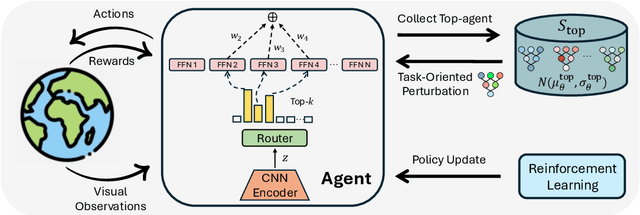
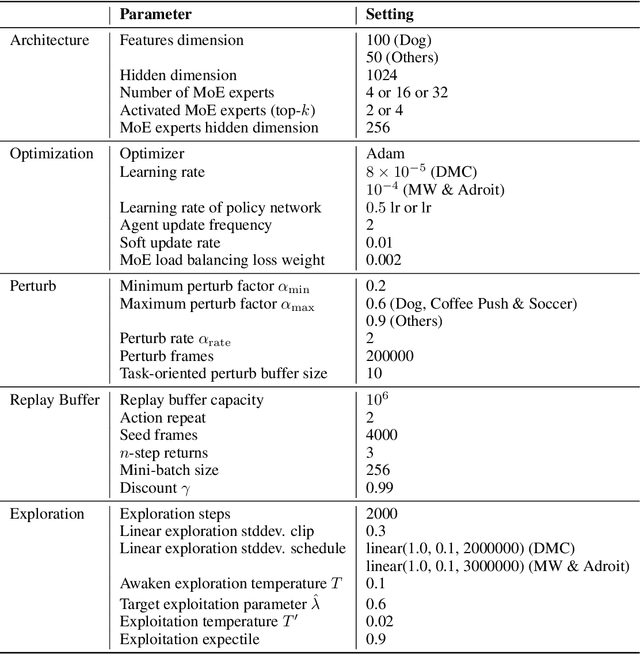
Abstract:Visual deep reinforcement learning (RL) enables robots to acquire skills from visual input for unstructured tasks. However, current algorithms suffer from low sample efficiency, limiting their practical applicability. In this work, we present MENTOR, a method that improves both the architecture and optimization of RL agents. Specifically, MENTOR replaces the standard multi-layer perceptron (MLP) with a mixture-of-experts (MoE) backbone, enhancing the agent's ability to handle complex tasks by leveraging modular expert learning to avoid gradient conflicts. Furthermore, MENTOR introduces a task-oriented perturbation mechanism, which heuristically samples perturbation candidates containing task-relevant information, leading to more targeted and effective optimization. MENTOR outperforms state-of-the-art methods across three simulation domains -- DeepMind Control Suite, Meta-World, and Adroit. Additionally, MENTOR achieves an average of 83% success rate on three challenging real-world robotic manipulation tasks including peg insertion, cable routing, and tabletop golf, which significantly surpasses the success rate of 32% from the current strongest model-free visual RL algorithm. These results underscore the importance of sample efficiency in advancing visual RL for real-world robotics. Experimental videos are available at https://suninghuang19.github.io/mentor_page.
Learning Semantic Latent Directions for Accurate and Controllable Human Motion Prediction
Jul 16, 2024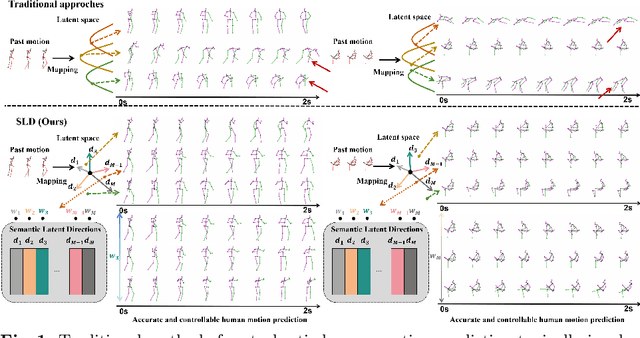
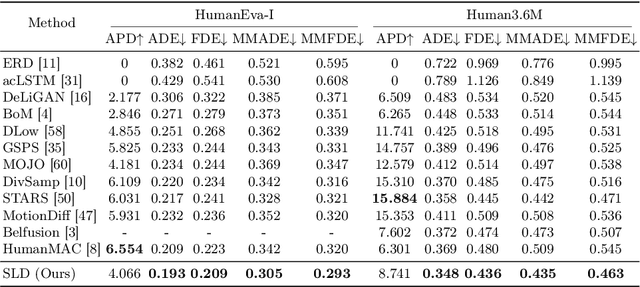
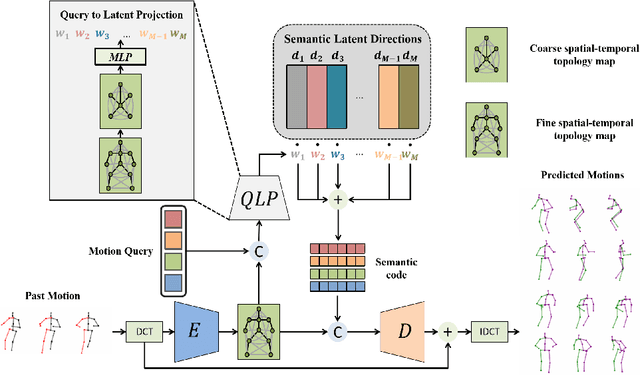

Abstract:In the realm of stochastic human motion prediction (SHMP), researchers have often turned to generative models like GANS, VAEs and diffusion models. However, most previous approaches have struggled to accurately predict motions that are both realistic and coherent with past motion due to a lack of guidance on the latent distribution. In this paper, we introduce Semantic Latent Directions (SLD) as a solution to this challenge, aiming to constrain the latent space to learn meaningful motion semantics and enhance the accuracy of SHMP. SLD defines a series of orthogonal latent directions and represents the hypothesis of future motion as a linear combination of these directions. By creating such an information bottleneck, SLD excels in capturing meaningful motion semantics, thereby improving the precision of motion predictions. Moreover, SLD offers controllable prediction capabilities by adjusting the coefficients of the latent directions during the inference phase. Expanding on SLD, we introduce a set of motion queries to enhance the diversity of predictions. By aligning these motion queries with the SLD space, SLD is further promoted to more accurate and coherent motion predictions. Through extensive experiments conducted on widely used benchmarks, we showcase the superiority of our method in accurately predicting motions while maintaining a balance of realism and diversity. Our code and pretrained models are available at https://github.com/GuoweiXu368/SLD-HMP.
ACE : Off-Policy Actor-Critic with Causality-Aware Entropy Regularization
Feb 22, 2024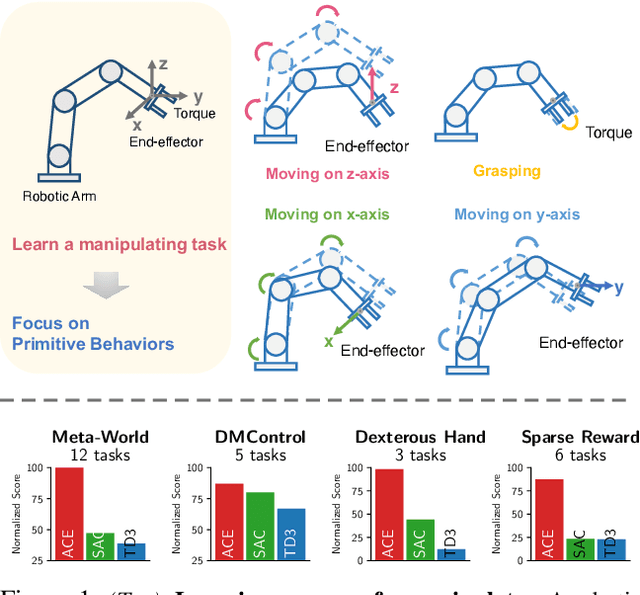
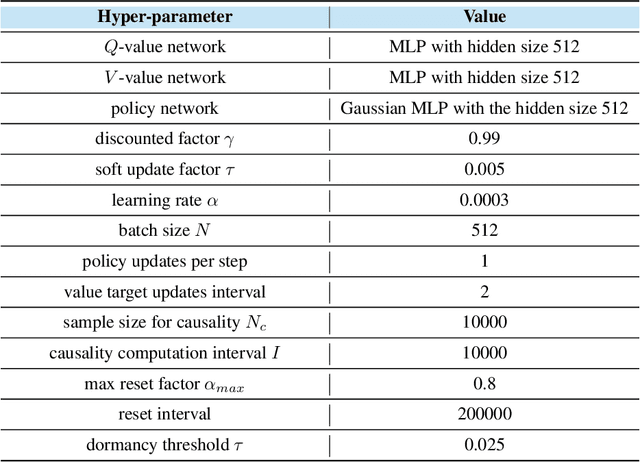

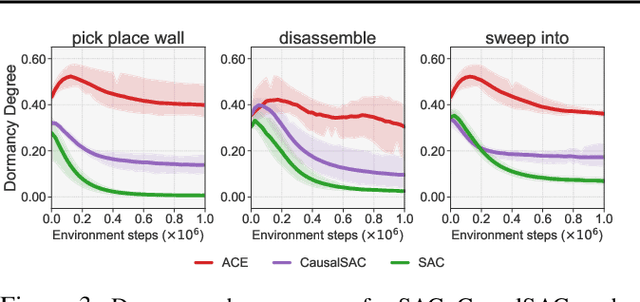
Abstract:The varying significance of distinct primitive behaviors during the policy learning process has been overlooked by prior model-free RL algorithms. Leveraging this insight, we explore the causal relationship between different action dimensions and rewards to evaluate the significance of various primitive behaviors during training. We introduce a causality-aware entropy term that effectively identifies and prioritizes actions with high potential impacts for efficient exploration. Furthermore, to prevent excessive focus on specific primitive behaviors, we analyze the gradient dormancy phenomenon and introduce a dormancy-guided reset mechanism to further enhance the efficacy of our method. Our proposed algorithm, ACE: Off-policy Actor-critic with Causality-aware Entropy regularization, demonstrates a substantial performance advantage across 29 diverse continuous control tasks spanning 7 domains compared to model-free RL baselines, which underscores the effectiveness, versatility, and efficient sample efficiency of our approach. Benchmark results and videos are available at https://ace-rl.github.io/.
DrM: Mastering Visual Reinforcement Learning through Dormant Ratio Minimization
Oct 30, 2023Abstract:Visual reinforcement learning (RL) has shown promise in continuous control tasks. Despite its progress, current algorithms are still unsatisfactory in virtually every aspect of the performance such as sample efficiency, asymptotic performance, and their robustness to the choice of random seeds. In this paper, we identify a major shortcoming in existing visual RL methods that is the agents often exhibit sustained inactivity during early training, thereby limiting their ability to explore effectively. Expanding upon this crucial observation, we additionally unveil a significant correlation between the agents' inclination towards motorically inactive exploration and the absence of neuronal activity within their policy networks. To quantify this inactivity, we adopt dormant ratio as a metric to measure inactivity in the RL agent's network. Empirically, we also recognize that the dormant ratio can act as a standalone indicator of an agent's activity level, regardless of the received reward signals. Leveraging the aforementioned insights, we introduce DrM, a method that uses three core mechanisms to guide agents' exploration-exploitation trade-offs by actively minimizing the dormant ratio. Experiments demonstrate that DrM achieves significant improvements in sample efficiency and asymptotic performance with no broken seeds (76 seeds in total) across three continuous control benchmark environments, including DeepMind Control Suite, MetaWorld, and Adroit. Most importantly, DrM is the first model-free algorithm that consistently solves tasks in both the Dog and Manipulator domains from the DeepMind Control Suite as well as three dexterous hand manipulation tasks without demonstrations in Adroit, all based on pixel observations.
Can Pre-Trained Text-to-Image Models Generate Visual Goals for Reinforcement Learning?
Jul 15, 2023



Abstract:Pre-trained text-to-image generative models can produce diverse, semantically rich, and realistic images from natural language descriptions. Compared with language, images usually convey information with more details and less ambiguity. In this study, we propose Learning from the Void (LfVoid), a method that leverages the power of pre-trained text-to-image models and advanced image editing techniques to guide robot learning. Given natural language instructions, LfVoid can edit the original observations to obtain goal images, such as "wiping" a stain off a table. Subsequently, LfVoid trains an ensembled goal discriminator on the generated image to provide reward signals for a reinforcement learning agent, guiding it to achieve the goal. The ability of LfVoid to learn with zero in-domain training on expert demonstrations or true goal observations (the void) is attributed to the utilization of knowledge from web-scale generative models. We evaluate LfVoid across three simulated tasks and validate its feasibility in the corresponding real-world scenarios. In addition, we offer insights into the key considerations for the effective integration of visual generative models into robot learning workflows. We posit that our work represents an initial step towards the broader application of pre-trained visual generative models in the robotics field. Our project page: https://lfvoid-rl.github.io/.
Towards Arbitrary Text-driven Image Manipulation via Space Alignment
Jan 25, 2023Abstract:The recent GAN inversion methods have been able to successfully invert the real image input to the corresponding editable latent code in StyleGAN. By combining with the language-vision model (CLIP), some text-driven image manipulation methods are proposed. However, these methods require extra costs to perform optimization for a certain image or a new attribute editing mode. To achieve a more efficient editing method, we propose a new Text-driven image Manipulation framework via Space Alignment (TMSA). The Space Alignment module aims to align the same semantic regions in CLIP and StyleGAN spaces. Then, the text input can be directly accessed into the StyleGAN space and be used to find the semantic shift according to the text description. The framework can support arbitrary image editing mode without additional cost. Our work provides the user with an interface to control the attributes of a given image according to text input and get the result in real time. Ex tensive experiments demonstrate our superior performance over prior works.
 Add to Chrome
Add to Chrome Add to Firefox
Add to Firefox Add to Edge
Add to Edge